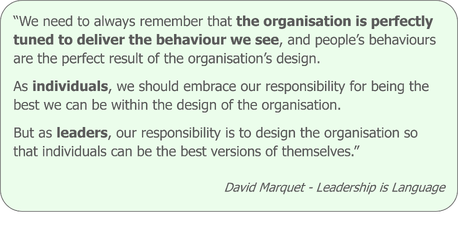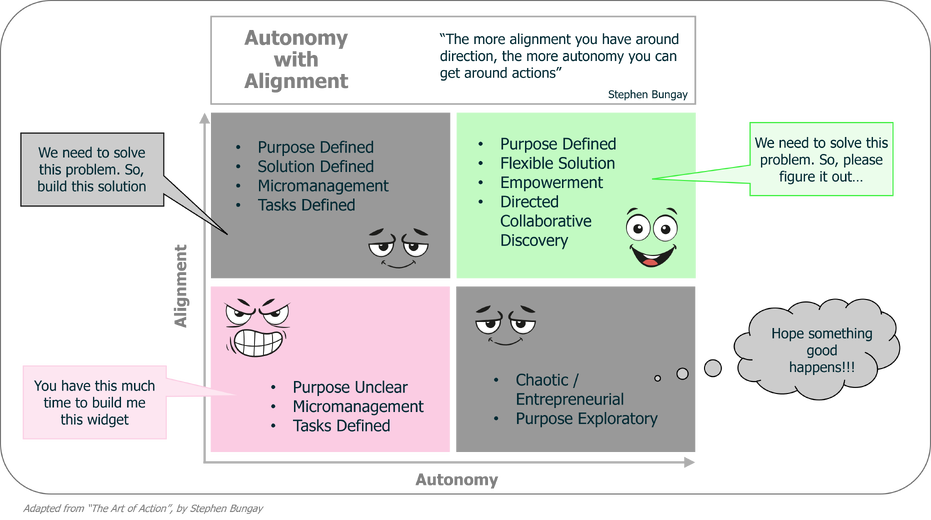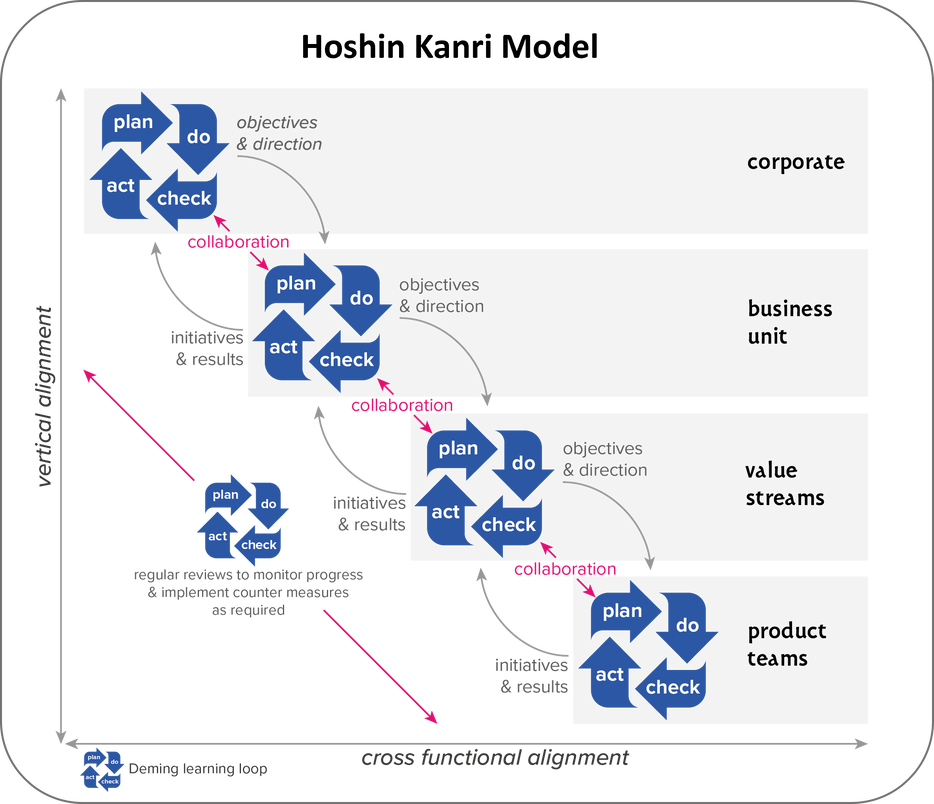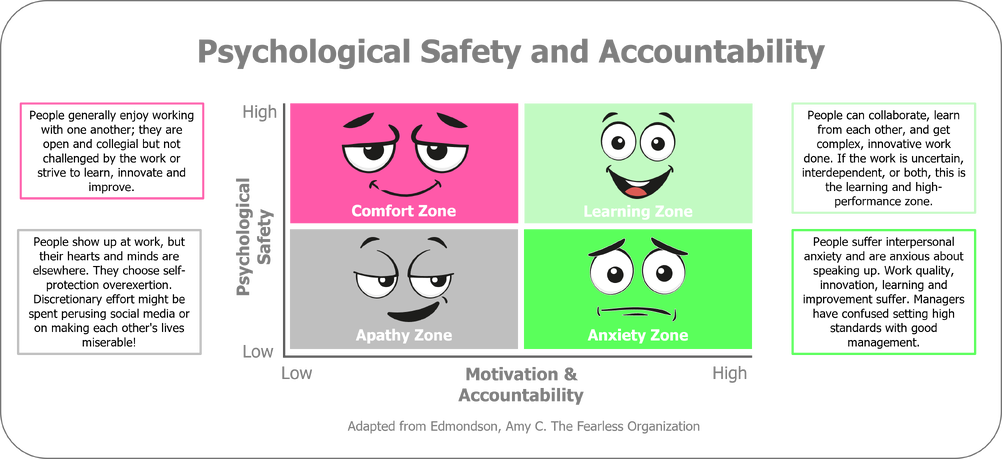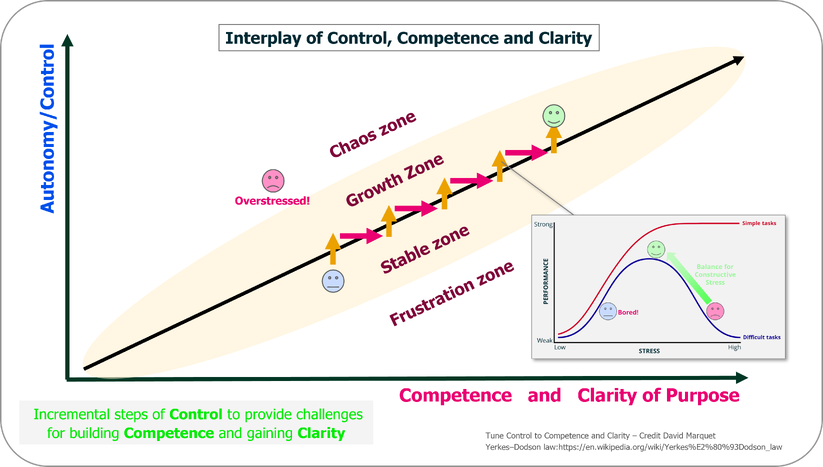The Leadership Perspective
Agile Leadership at Scale
The genesis of the Agile movement emerged from the challenge of trying to solve problems in the complex world of software development. Today's complex, fast-moving business environment requires a different leadership style that incorporates many of the ideas from Lean and Agile.
It is possible for a few Agile teams to “fly under the radar” and use their agility to improve their performance within an unfavourable, less than agile organisational context. However, this individual team performance gain will have a limited impact on customer and business value generation and will ”fail to scale” unless there is wider, end-to-end change. Transforming to an Agile organisation that can successfully scale value generation improvements requires systemic and cultural change that requires the sustained support of leaders.
Here's a summary of some of leadership's key responsibilities and concepts involved in creating an agile organisation at any scale:
The Context for Agile Leadership
Organisations are challenged to stay relevant and competitive in today's VUCA (Volatile, Uncertain, Complex, Ambiguous) world. Outstanding leadership effectively harnesses an organisation's collective capabilities into a resilient, responsive, adaptive and ever-improving entity - an Agile organisation - that will be more likely to survive and thrive.
Focus on People
Agile leaders perceive their organisations as intricate human systems, acknowledging the complexity of their behaviour, interactions, and development, necessitating a systemic approach.
Agile leadership focuses on growing and nurturing the environment for people to thrive and less on traditional ideas of people management. A fertile environment is one that includes high levels of Psychological Safety that encourages experimentation, learning and growth and provides aligned autonomy of action and engagement through clear and meaningful purpose and involved decision-making.
Apply Systems Thinking
Agile is broader than delivery teams. Agile incorporates high-function teams as the atomic entity of value creation, but its values and principles extend to the whole organisation as this provides much of the context within which teams operate. The result is that regardless of size, almost any serious Agile endeavour involves Agile at Scale. This will require leadership support for the systemic improvement of the entire system of value creation to be successful and sustained.
Build Leadership Capability
Leadership is not a role but a capability that should exist and be nurtured throughout the organisation, from team members to CEO. Peter Drucker famously said that the role of leadership is to create an alignment of strengths (quote: https://www.azquotes.com/quote/872896).
In modern knowledge-based organisations, this alignment comes from what David Marquet (ref Turn the Ship Around) calls Leader – Leader relationship, to differentiate from the traditional Leader – Follower approach.
Put another way, it is a core responsibility of leadership to promote participation and collaboration while growing more people capable of leadership to establish the backbone for an empowered and engaged organisation.
Own Your Own Approach
Steve Denning has researched many organisations that have scaled Agile; he has published findings across organisations that highlight the leadership required to support and sustain a successful Agile journey. As well as the observation that longterm leadership support was required for the Agile journey, another key finding was that the approach was homegrown and emerged organically.
Simply copying and pasting in “Best Practice” from other organisations or consultancies is unlikely to create a competitive advantage, and there is no guarantee that it will suit your unique organisational context and culture. Leadership takes responsibility for catalysing a direction and purpose for change that guides a process of emergent practice.
(Principle: Own your own approach)
Catalyst for Change
Agility is not achieved through a transactional transformation from the old way of working to a new way! Instead, it is a long-term commitment to improve the value realised by the organisation. A key leadership responsibility is to help the organisation build into its cultural DNA the imperative and capability to evolve perpetually.
Some changes will be challenging and will require the courage and support of leadership to accomplish the structural changes needed to reduce complexity. The average organisation is the result of cumulative changes that have been applied over years, often using a scientific reductionistic approach implemented through a hierarchical ladder (ref: https://explorable.com/scientific-reductionism), often resulting in short-sighted local optimisations.
However, optimising for outcome generation requires a holistic approach to continuously adapt the value streams to the ever-changing challenges of the VUCA world. Modern leadership has the incredibly important challenge of working together at all levels to adapt the organisational structures beyond, and often against, current locally optimised silo-thinking. This work requires a long-term strategic vision, and, at the same time, it’s an emergent evolutionary process that requires broad participation, learning and commitment.
Aspects of Agile Leadership
Leadership Behaviours
Great leaders can inspire, orient, give trust and respect, offer purpose, invite participation, and promote growth. At all levels, the leaders of an organisation are role models for how leadership is implemented in an organisation. Employees' perception of their leaders is a critical factor in how they will choose to act in the company. Leaders positively “infect” the organisation with their values because they live them, not because they state them!
On the contrary, bad leaders criticise, are selfish, use people, don’t trust others, and work for their own interests. This creates a corrupted environment where the company goals are subordinated to those of individuals, severely reducing cohesion and effectiveness.
In his book, Leadership is Language, David Marquet neatly articulates the impact and responsibility of leaders for the organisation's culture:
An Agile Leader strives to understand the impact of the current environment on behaviours and catalyse and support the changes required to promote positive changes in behaviours. Examples of environmental factors include leadership behaviours, policies, Psychological Safety, purpose, performance management, procedures, facilities etc.
The very culture of a company, i.e. the system of beliefs and values espoused throughout the organisation, is shaped to a large extent by the actions of leaders:
With their visibility and connectedness, leaders have significant systemic importance in spreading and shaping the system of beliefs and values espoused throughout the organisation. By doing this, they actively cultivate the company culture.
Leaders can catalyse a meaningful purpose by being role models (Principle: Create meaningful purpose). We deliberately use the word “catalyse” here because, to empower our human capital, leaders should avoid “giving orders” but instead support the emergence of a collaboratively created shared vision.
In particular, with their behaviours, leaders can support the creation of a culture of change and adaptiveness by showing openness to it and acting as catalysts for change (Principle: Catalyst for change) while, in parallel, maintaining an environment where people feel psychologically safe.
For more information on the importance of being a role model, see these articles as an entry point into the research on the subject:
https://people-equation.com/leaders-as-role-models-research/
https://www.sciencedirect.com/science/article/pii/S0167268118302063?via%3Dihub
Human Aspects
Both Lean and Agile are people-centred approaches. Regardless of how smart our processes and systems are, we will fail if we do not engage and harness the capabilities of our people. The current potential of an organisation is a function of its past recruitment and growth of its people and the environment that supports them. Continuous investment and attention to developing people is the key to the sustained success of any organisation.
Autonomy
We define Autonomy as the ability to effectively function with a high degree of independence with limited reliance on outside decision authority or services.
Leadership seek to create an environment that provides a high level of team autonomy to provide the following benefits:
- Motivated people
- Engaged people
- Low latency decision-making
- Responsive organisation
However, for autonomy to be effective, it is essential:
- That there is good clarity of meaningful purpose to guide and align decision-making and actions in a cohesive and productive direction. Additionally, the purpose should be expressed as outcomes rather than execution instructions - the “what” and the “why” rather than the “how”.
- Those responsible for the work are also accountable for and have the authority to make decisions and take actions within a set of agreed constraints (outcome, quality, tactics, etc...).
- Accountability is balanced by the “safety” to fail, learn and improve.
- The level of autonomy and authority provided is compatible with the capability to execute in combination with leadership coaching and support.
- To grow the capability to enable greater autonomy and authority to be devolved - see Creating a Learning Organisation below.
Alignment and Autonomy
To answer the challenge of engaging many minds in a cohesive, collaborative and effective manner, we must ensure clarity of shared and meaningful purpose to provide essential alignment. A meaningful purpose is an important aspect of motivation. It is also necessary for teams to function with good autonomy - another aspect of motivation (see Bounded Autonomy).
Leaders “Catalyse purpose” rather than “Set purpose”. This might seem like a subtle distinction, but nonetheless, it is vital. In many organisations, senior leadership sets the purpose and pushes it down the organisation. However, this approach has shortcomings:
- A lack of understanding, buy-in and engagement from the people delivering the strategy.
- The strategy formulation needed to achieve impactful product and service delivery will suffer due to missing more detailed and diverse perspectives, data and feedback.
- High-level goals will require decomposition into more detail as they move down the layers. A cascade hand-off process leads to a loss of tacit information in transit and a “Chinese whisper” effect reducing the quality and alignment, resulting in less meaningful and valuable work sub-components.
There are many techniques and formats that can be used to express purpose and track progress, including OKRs. Regardless of the method chosen, the critical factor is how the objectives are created, communicated and measured. To catalyse rather than "set" purpose, leaders facilitate an iterative and collaborative process with two-way feedback loops. The diagram below illustrates a Hoshin Kanri approach (also known as Strategy Deployment) that, if utilised correctly, will support the emergence of a well-formulated and aligned purpose:
The diagram contains 4 example levels of detail; however, specific organisations and contexts could require more or less. What is essential is how collaboration and consensus-building work through the layers. There are many different patterns and interpretations that can be applied within this model. However, here are some core guiding principles:
- Collaborative conversations and understanding-building are more critical than documented expressions of purpose.
- Formulation of purpose at each layer is in collaboration with adjacent layers.
- Align to value streams and promote end-to-end cross-functional collaboration.
- Agree on appropriate time horizons at each layer.
- It is an iterative process with regular refinement and learning. Regular refresh cadences should be established, but there should also be iteration within these cadences - i.e. ideas should be honed through rapid iterative feedback loops.
- The outcome should result in objectives at the lowest level being cohesive with, and traceable back to, the highest level mission.
- Just Enough Detail - keep it light and outcome-focused to avoid over-analysis waste and protect empowerment to decide how the objectives are met.
- Leaders seek to elicit diverse ideas and avoid anchoring group input within the constraints of their own thinking.
- This is not a cascade model!
Balance Autonomy
Simply handing out the freedom and authority to be autonomous with instructions to self-manage and do great work is not enough. It will more than likely lead to chaos!
Having established alignment and Shared Context through the Creation of Clarity of Purpose (see Aligned Autonomy), we balance autonomy by:
- Ensuring that the level of responsibility applied is proportionate to the capabilities of the people. The level of capability will vary by group and over time, so will need to be context-specific and evolutionary.
- Supporting as needed to resolve impediments, coach, grow capability and adjust the level of responsibility as required.
- Bound Autonomy (see Effective Autonomy with Boundaries in the Team Perspective) to ensure that people know what they have the authority to autonomously decide versus what may need outside consultation.
The aim of balancing responsibility and capability is to provide a challenging and enabling environment without overwhelming individuals. Leadership ensures that learning is incorporated into the ways-of-working to grow capabilities and enable careful adjustment of responsibilities in alignment with growth.
Trust and Safety
In this Leadership Perspective, we discuss many facets of Agile Leadership. Ideas such as devolving autonomy, accountability and authority, leading and supporting change, and creating a Learning Organisation will stall or fail unless there is a strong basis of trust and safety.
Leaders have a duty to build an environment that broadly (i.e. beyond senior leaders) promotes and supports:
- Challenge the status quo - the ability to honestly and critically analyse the current system of work with a mindset to discover, drill down and fundamentally address root causes of challenges to value creation.
- Process Innovation - engage people who live the process to contribute their deep knowledge to shape and run change experiments with new or modified processes, systems, tools, policies, etc.
- Product Innovation - innovating, by definition, means taking different and divergent approaches with an inherently higher risk of failure. If trying and failing are career-limiting, people will disengage and stop trying anything new or perceived as risky.
- Accountability and autonomy - without the trust that it is safe to take accountability and autonomous decision-making, people will switch to a passive mode, disengage and wait for permission or to be told what to do.
- Learning - the ability to safely admit that we don’t know something opens up the opportunity to learn as well as potentially unblock progress or avoid failure and rework.
- Critical failure avoidance - through the safety and trust that constructively raising early visibility of potential issues will not be penalised.
Project Aristotle, a multi-year study of team effectiveness at Google, concluded that Psychological Safety was the number one determining factor differentiating the highest-performing teams. The study found that how the team collaborated and functioned as a unit was far more important than the capabilities of individual team members.
Five key aspects were identified:
- Psychological Safety to take risks, speaking up, supported by team members
- Dependability - they can count on their team members
- Structure and Clarity - clear direction and goals
- Meaning - work is personally meaningful
- Impact - the work matters and will deliver benefit
Psychological Safety was the key enabler for the four other aspects to prove valuable.
Amy Edmondson defines Psychological Safety as ”a belief that one will not be punished or humiliated for speaking up with ideas, questions, concerns or mistakes…”
It seems such a simple statement, but without Psychological Safety, nothing good happens: errors and issues remain hidden, and learning and improvement are stunted. With high levels of Psychological Safety, we open the door for greater engagement and innovation, improved work quality and collaboration, and support for learning and process improvement.
Establishing a safe environment is a priority for leadership to ensure that less bravery is required to identify and explore current challenges down to their root causes. Reducing the “fear of failure” will enable experiments to safely explore innovative solutions and identify and apply learnings.
That said, Psychological Safety is not about being nice or avoiding accountability. Instead, it is an environment where it is expected and safe to hold difficult conversations and be accountable for high-performance delivery towards target outcomes. Psychological Safety does not mean that accountability is compromised. Instead, they are, in fact, two different dimensions - see how they relate in the graphic below.
Create a Learning Organisation
The current potential of an organisation is founded on the collective capabilities of its people. Today’s knowledge and capabilities are a function of previous learning and experiences. To ensure sustained success, intentional, ongoing investment and attention to developing people are required.
Below we discuss some strategies that will help build a Learning Organisation.
Create the Space to Learn
Create time to learn by building in and protecting time in day-to-day work to avoid the state of constant busyness denying the opportunities to learn and develop skills. Encourage and value the inclusion of learning outcomes in addition to delivery outcomes (e.g. include a learning outcome within a Sprint Goal).
Working and collaborating closely in small groups helps create an environment where learning is a natural byproduct of getting the work done. Extreme Programming introduced the concept of Pair Programming, where two developers work with a single keyboard – pilot and co-pilot. Although not the primary intention, one of the collateral benefits is a safe learning environment. The broad concept of pairing can be adapted and applied to many types of knowledge work. In scaled environments, it can even be used with people from different teams for specific cross-team challenges. One of the reasons this strategy is used less than it should be is the perceived loss of productivity and efficiency. Counterintuitively, long-term value creation will likely increase for many reasons, including the learning benefit.
Recognise the Value of Learning
The valuable outcomes from the work people perform include both what they deliver (products & services) and what they learn! Of course, a great environment is required to provide the platform to turn potential into realised value.
Personal objective setting and performance sessions should include learning and coaching objectives where appropriate. Where a person has deep subject matter expertise, they should be encouraged and recognised for raising the skills of others as well as contributing to delivery outcomes. Conversely, the same person may have potential growth areas that can be encouraged with suitable objectives and recognition.
Leaders Develop Themselves
Leaders lead by example, making the time for their own learning and developing their leadership skills. Additionally, they seek constructive feedback with an open mind to reflect and target improvements in weaker areas. These practices have the following benefits in addition to the obvious advantage of greater leadership capability:
- Demonstrates humility and vulnerability by acknowledging that they are never the finished article and have things to learn.
- Peer coaching helps practice and improve coaching skills as well as accelerate leadership skills development.
- Reinforces the learning culture and perception of the value of learning.
Safety to Learn
It should be recognised that in complex domains, failure is highly likely. It is also true that in these domains, there is a great deal of learning potential from things that don’t work as intended. Leadership creates the safety to attempt challenging outcomes and support the learning from “failure”. Another way of looking at this is to consider and lower the current level of bravery required to attempt something difficult and learn from the result. Leaders frame the work to include the appropriate expectation on the predictability or otherwise of the outcome. This is followed by constructive responses to unexpected results and guide inspection with curiosity and a genuine interest to maximise learning.
Admitting that we don’t know something is a vital start to initiate the opportunity to learn. But what will my colleagues or boss think if I don’t know something I suspect they think I am paid to know? To help build a learning-friendly environment, leaders lead by example, demonstrate vulnerability and a Growth Mindset, admit where they don’t know something, and model desired behaviour by asking questions.
Leaders Coach and Support
Leaders act as coaches and mentors to grow and support people in addition to formal training as part of personal learning and development plans.
Leaders adjust the level of autonomy and authority based on capability. Ideally, the balance should achieve a level of challenge that is inspiring and leads to growth but does not overstress.
For more information on the ideas of Tuning Control to Competence, and Clarity, see David Marquet's video
Support Change
The Change Perspective discusses why the ability for continuous improvement should be a core capability and cultural mindset and presents an evolutionary change model as a practical approach for achieving this.
Leadership has a vital role in shaping and supporting change:
- Catalyse a clarity of purpose to provide context and motivation for change.
- Create the safety necessary to challenge the status quo and experiment with new ideas.
- Provide support where experiments inevitably lead to parts of the organisations at different states of change.
- Provide the authority to make fundamental changes across organisational boundaries and politics.
- Support a systems thinking approach to optimise end-to-end value streams and avoid local optimisation pitfalls.
- Lead by example, for example, demonstrating an openness to question assumptions, especially your own.
- Reinforce the concept that this is not a change initiative but rather a long-term commitment to continuously seek perfection in the way the organisation creates value.
- Create the time for change. Ensure time is built into busy schedules to understand the current context and create and evaluate hypotheses. This includes key stakeholders making the time to engage in change activities.
We recommend organisations identify Value Streams that can be used to align teams to deliver value towards strategic business objectives (a greater good). Applying an incremental, evolutionary change approach to identified value streams [ref link] . [link to change perspective].
This approach will lead to parts of organisations at different states of change, with some departments operating more bureaucratically alongside Agile Value Streams. We have observed this causes tension in areas such as project budgeting, scope/time/cost project-based approach, line management, departmental structures and functional departments trying to work with Agile teams. Leadership is required to support and work through these challenges.
Most sizeable organisations do not change as a whole entity; instead, parts evolve at different speeds and often in different directions. We recommend that this phenomenon be embraced and formalised, using go-ELSE principles to guide evolutionary change, supported and protected by recognised boundaries, with the authority to challenge existing procedures where they impede the effectiveness of Agile Value Streams.
Enable Effective Value Delivery
Following the scaling principles should create organisations that are aligned to and are able to observe the impact of their value creation. Leadership should ensure that “this line of sight” is available to any of the teams working within that value stream and the direction of purpose is clear for those working towards it.
Progress towards goals should be visible and widely available, and the measures used should be meaningful, actionable and easily understood. Principle [Outcome is the primary measure of progress].
The more often output can be provided for feedback, the more frequently teams can learn from that feedback and act on the information. The wider the audience and the closer the product is to a released version, the more reliable the data.
Earlier product iteration feedback from smaller audiences will require greater judgment. Create an environment with structures that enable effective decision-making by the people with the most knowledge of the work.
Leadership should ensure they leave biases aside and can adapt when new information challenges previously held beliefs. Engaging in dialogue based on data insights, providing guidance and clarity of judgement to continue or change the direction of experimentation for the benefit of the wider organisation.
Leadership should ensure that they embrace this discovery and outcome-led approach, supporting teams using product iterations to sense and respond to feedback in order to enable effective value creation and outcome realisation. Embracing the idea that even the seemingly most certain requirements should be treated as assumptions that require validation.
Throughout this process, leadership should encourage and support alignment across teams, enabling cross-team collaboration and effective dialogue and making the best decisions based on the information available rather than based on opinions and positions in the hierarchy.
Leadership Perspective Summary
Agile Leadership at Scale highlights the necessity for a leadership style that is adaptable and responsive to the complexities of the modern business world. Central to this approach is the focus on fostering resilient and agile organisations capable of thriving in an environment characterised by volatility, uncertainty, complexity, and ambiguity.
Agile leadership strongly emphasises understanding organisations as dynamic human systems and creating environments encouraging psychological safety, learning, and autonomy.
There is an emphasis on systems thinking, integrating Agile principles throughout the organisation, and developing leadership as a widespread capability across all levels. Leaders are encouraged to tailor Agile practices to their unique organisational contexts and act as catalysts for systemic and cultural change.
The human element is pivotal, with a balance between autonomy and capability and the establishment of trust and safety being fundamental. Creating a learning organisation is crucial, where leaders support and coach team members, fostering continuous learning and adaptation.
In driving change, leaders need to catalyse a clear purpose, encourage experimentation, and align organisational changes with business objectives.
Overall, Agile leadership at Scale advocates for an adaptable culture, focused on continuous learning and centred around people, where leaders guide and facilitate rather than control, ensuring effective execution and ongoing organisational improvement.
